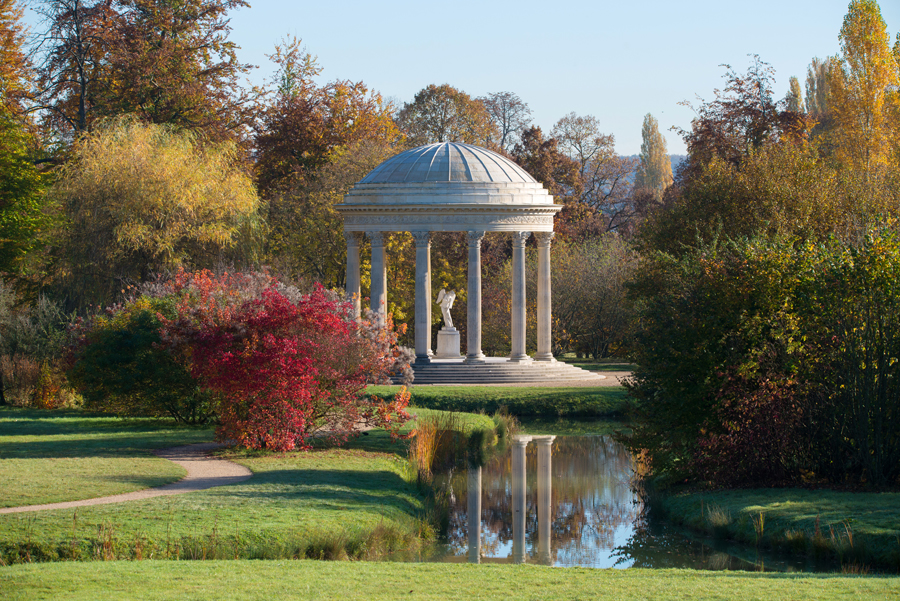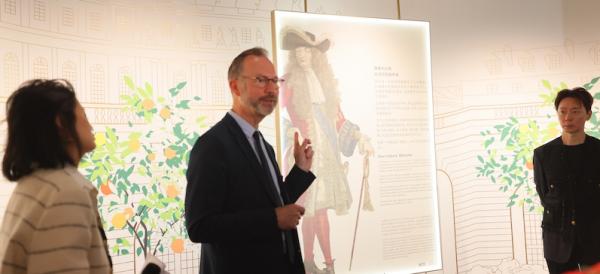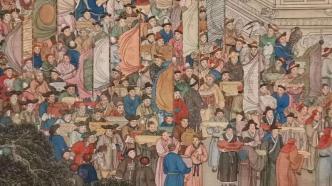
2024 is the 60th anniversary of the establishment of diplomatic relations between China and France, and also the Year of French-Chinese Culture and Tourism. As a cultural project of the "Spring of Sino-French Culture - Special Presentation of the 60th Anniversary of the Establishment of Diplomatic Relations between China and France" and the "Year of Sino-French Culture and Tourism", the "Glorious Versailles" exhibition was recently exhibited at the Yinglan Center in Hangzhou. On the opening day of the exhibition, Laurent Salomé, director of the National Museum of the Palace of Versailles and Trinon in France, accepted an exclusive interview with The Paper on the spot.
"I hope that the Palace of Versailles will be more and more faithful to the real history. The Palace of Versailles was once looted. The Versailles that people see today is the result of two centuries of continuous efforts. It can be said that we have rebuilt the Palace of Versailles. For example, we have repurchased the collections lost by the Palace of Versailles during the French Revolution from the United States and other regions. Our goal is both humble and grand, which is to rediscover the true history of the Palace of Versailles. At the same time, expand the influence and image of the Palace of Versailles." said Laurent Salome.

Real view of the Palace of Versailles

"Glittering Versailles" Hangzhou Exhibition
As one of the five largest palaces in the world, the Palace of Versailles and the National Museum of Trinon (hereinafter referred to as the Palace of Versailles) are a model of the architecture of the "Glorious Age" in the 17th century. The palace was once the hunting palace of Louis XIII, and was later expanded and renovated by his son Louis XIV. The latter moved the court and government of the time to Versailles in 1682. Kings lived there until the French Revolution, and each generation of monarchs added bricks and tiles to the Palace of Versailles, creating many classic places such as the Hall of Mirrors, the King's Suite, and the French History Museum. Over the centuries, the Palace of Versailles has never stopped developing. The collection of the Palace of Versailles covers a wide range of fields, with about 60,000 collections, reflecting its special dual identity: the former monarch's palace and the museum that was completed in 1837 to "present all the glory of France."
Laurent Salomé is a graduate of ESCP Europe and the Louvre Institute and the National Institute of Cultural Heritage. He was Deputy Director of the Grenoble Museum (1990-1995), Director of the Rennes Museum of Fine Arts (1995-2001), Director of the Rouen Museum (2001-2011), and Director of the Grand Palais and the National Federation of Museums of France, responsible for the exhibition projects of the Grand Palais and the Luxembourg Museum (2011-2016). In 2016, he was appointed Director of the Palace of Versailles Museum, where he has been actively promoting the renovation of the palace, expanding the exhibition project and enriching the collection.

Laurent Salomé at the “Versailles Splendor” exhibition
"For us, the traditional exhibition that opened in the Forbidden City in April this year and the virtual exhibition in Hangzhou complement each other. They are two different ways to understand and explore this common history between China and France," Laurent Salome, director of the Palace of Versailles, told The Paper. "The special thing about the 'Glittering Versailles' exhibition is that it presents some content that has not yet been opened to the public. For those who have been to Versailles, you can experience the mysterious part of Versailles through interactive games and on different installations. For those who have not been to Versailles, we invite you to explore the glorious history of Versailles and generate a yearning to come to Versailles."
Conversation|Laurent Salomé
The Paper: Could you please give us some basic information about the Palace of Versailles Museum? After you became the director of the Palace of Versailles Museum in 2016, what are your thoughts on the positioning and planning of the Palace of Versailles?
Laurent Salomé: It is difficult to give a brief introduction to the Palace of Versailles because it is an extraordinary, huge, very complex and unique place. It is both a historical site and a symbol of French history, and a museum with a vast art collection. At the same time, it also has vast gardens with several castles, including the Palace of Versailles, the Grand and Petit Trianon. It can be said that this combination is unique in the world. For us, it is also a challenge to manage such a complex and keep it alive. Fortunately, the Palace of Versailles itself is very attractive. It is so beautiful and huge that it attracts many tourists.

Palace of Versailles
I hope that the Palace of Versailles will be more and more faithful to the real history. It was once the center of the monarchy, magnificent and splendid, but everything was overturned during the French Revolution. The Palace of Versailles was looted and was vacant at the end of the 18th century. The Palace of Versailles that you see today is the result of two centuries of continuous efforts. It can be said that we have rebuilt the Palace of Versailles. For example, we have repurchased the collections that were lost during the Revolution from the United States and other regions. Our goal is both humble and grand, which is to find the real history of the Palace of Versailles. At the same time, it is also very important to me to expand the influence and image of the Palace of Versailles. Many people think of Louis XIV and Queen Marie when they mention the Palace of Versailles. Some tourists mistakenly think that they are husband and wife. In fact, they are not husband and wife. In fact, they are in completely different eras. The history is much more complicated than this. Talking about the history of the 19th century, we have the richest collection of Napoleon in France. Later, the Palace of Versailles also became a museum that witnessed the glorious history of France. We have also built a collection similar to the National Portrait Gallery, where you can find portraits of almost all the important figures in French history. In short, I hope to present a more extensive and richer image of the Palace of Versailles.

The portrait of Louis XIV in formal attire is not on display
The Paper: This exhibition in Hangzhou has received a lot of attention. I would like to ask how to experience the Palace of Versailles here? What is the biggest difference from previous Palace of Versailles exhibitions in China? What are the creative ideas of the virtual exhibition and immersive tour of the Palace of Versailles?
Laurent Salomé: First of all, this is a completely virtual exhibition, a new attempt different from the traditional collection exchange exhibition. New digital technology also allows us to tell more stories and create an immersive exhibition space to experience the Palace of Versailles and its gardens. You can also get more information about the collection through interactive experience devices. There are also many sections that combine learning and entertainment functions, which are fun and educational. The main purpose of the exhibition is to inspire the public's interest in visiting the Palace of Versailles. We also try to create an atmosphere. For example, the last chapter shows "A Day in the Palace of Versailles", which presents the intuitive feeling of being in the Palace of Versailles, from sunrise to sunset, the sun shines on the gardens and buildings... Because this is a very special museum, sometimes personal feelings may be more important than knowledge output.
The Paper: Why does this exhibition focus on a figure like Queen Mary and bring about an exclusive room display?
Laurent Salomé: Queen Marie was a figure that received much public attention and love, maybe. She was very important because, on the one hand, she represented the most refined and luxurious era in France, and was the embodiment of the lifestyle of the Palace of Versailles. She did change the Palace of Versailles. She married to France from Austria. Before her arrival, the image of the Palace of Versailles was rigid and serious. She brought lightness and elegance to the Palace of Versailles, as well as the luxury goods she loved. Later, her tragic fate on the guillotine made her life full of legends and mystery. Even though Louis XV's queen reigned longer, she was far less well-known than Queen Marie. In the exhibition, we made a private space for her. Queen Marie preferred to create a private space of her own in the Palace of Versailles at that time rather than a large apartment. She also liked China, and we also presented some Chinese elements, such as the pavilion in the garden of the Petit Trianon, whose decoration was deeply inspired by Chinese elements, such as fragrance sprays. The garden of the Petit Trianon is also called the Anglo-Chinese garden, which was also a popular style at the time, with a British-style garden and Chinese-style rock decorations. This is why we set up a special room for Queen Marie.

The portrait of Queen Mary is not on display

English-Chinese Garden
The Paper: In 2004 and 2005, the Palace of Versailles and the Palace Museum cooperated to hold the "Emperor Kangxi Exhibition" and the "'Sun King' Louis XIV - Special Exhibition of Treasures from the Palace of Versailles, France" respectively. In 2014, the Palace of Versailles held an exhibition called "China in Versailles - Art and Diplomacy in the 18th Century". In April this year, the "Forbidden City and the Palace of Versailles - Sino-French Exchanges in the 17th and 18th Centuries" was held in the Palace Museum in Beijing. What kind of concepts and planning are these series of exhibitions based on?
Laurent Salomé: These exhibitions are also very important to us. We have conducted scientific research on the collections of the Palace of Versailles for a very long time, studying the historical origins of the Sino-French bilateral relationship. In other words, European envoys, missionaries, and priests investigated science and culture in China, and also brought French culture to the Chinese emperor, for example, they taught the emperor mathematics courses at that time. We have done a very detailed study of this period of history. The collections exhibited in the Forbidden City in Beijing this time well interpret the historical features of the time, and there are also many collections of the Forbidden City itself. For example, we found some cultural relics that King Louis XIV gave to China in the Forbidden City, and we didn't know about this batch of cultural relics before. We found traces of the mutual influence of Chinese and French cultures in the porcelain, scientific instruments, books and other objects of the time, and also confirmed the curiosity of both China and France about each other in many fields such as philosophy, literature, and technology. For us, this traditional exhibition in the Forbidden City and the virtual exhibition in Hangzhou complement each other and complement each other. They are two different ways to understand and explore this common history between China and France. And the exhibition in Beijing will also appear in Hong Kong in another form in December this year.

Laurent Salomé (center) at the “Versailles Splendor” exhibition

The opening ceremony of the "Glittering Versailles" exhibition in Hangzhou
The Paper: In addition to cooperation with cultural institutions such as the Palace Museum, which other Chinese cultural institutions have you had in-depth cooperation with in the past, and what cooperation plans do you have in the future?
Laurent Salomé: We are still in the initial stage of cooperation with Chinese institutions. In addition to this exhibition with the Palace Museum and Hangzhou, we are also cooperating with museums in Hong Kong and Macau on the virtual exhibition of Versailles. Apart from this, we have not cooperated with other Chinese museums. I think this is just the beginning. We are also communicating with colleagues from the Shanghai Museum to see what is possible in the future.
The Paper: The Palace of Versailles has also witnessed the long history of cultural exchanges between China and France. What "Chinese elements" and "Chinese styles" are left in the Palace of Versailles?
Laurent Salomé: There are actually many Chinese elements in the Palace of Versailles. Starting from Louis XIV, especially in the 18th century, there was a craze for China. Many collectors and ministers were fascinated by China, and archaeologists also collected Chinese objects. We even have a porcelain panel painting handmade in Sevres, France, which is a portrait of Emperor Qianlong ordered by Louis XVI at the time.

Portrait of Emperor Qianlong ordered by Louis XVI, porcelain panel painting, 18th century, collection of the Palace of Versailles, not on display this time
Interestingly, Chinese objects were also adapted to French tastes when they came to France. For example, porcelain was painted golden brown. We might think this was disrespectful to Chinese porcelain, but it was actually the opposite. It was our way of re-valuing it, such as adding golden brown decoration to celadon vases. We also produced beautiful furniture based on Chinese lacquerware, because Chinese lacquerware was popular at the time, and so was Japanese lacquerware. For example, we would dismantle a Chinese lacquer cabinet and reconstruct a French cabinet with the door panels.

Blue and white porcelain vase, 18th century, Qianlong period, from the collection of the Palace of Versailles Museum, not on display this time

Celadon vase, 18th century, Qianlong period, from the collection of the Palace of Versailles Museum, not on display this time
The Paper: Historically, Louis XIV was a "China fan". He not only collected Chinese porcelain, but also incorporated Chinese porcelain decorative elements into palace architecture. Queen Marie Leszczynska, wife of Louis XV, was also a key figure in promoting Chinese culture. Marie-Antoinette, Queen of Louis XVI, was a fan of Chinese-style porcelain... It can be said that Chinese culture and art have had an important influence on Western art, especially French art. In modern times, French culture and art have also had a huge impact on Chinese artists. How do you view the civilization and artistic exchanges between the two countries?
Laurent Salomé: I would say that this story is still going on. China and France are two countries that pay attention to each other. In today's globalized context, many of the things we see are very similar. Sometimes artists travel around the world, study, or receive art education abroad, but I think this is more of a phenomenon at the end of the 20th century. Today's artists continue to look at the world, but they are still very attached to local culture in their hearts. For example, the great contemporary Chinese artists who are very popular in France are still very Chinese in their hearts. Even if it is very conceptual and abstract art, it is still different from the art forms of the United States and Europe. In France, you can see many large exhibitions of Chinese artists, and I think we should continue in this direction. For example, in the Palace of Versailles, I hope to hold an exhibition of heavyweight Chinese artists in the future, but it has not yet been realized.
The Paper: As one of the five largest palaces in the world, the Palace of Versailles is a must-see for Chinese tourists visiting France. What measures has the Palace of Versailles taken to attract Chinese tourists?
Laurent Salomé: That's true. Chinese tourists used to be one of the most important groups of tourists at the Palace of Versailles. Before the epidemic, they accounted for 12% of the total number of tourists, but today it is only 2%, so we look forward to the return of Chinese tourists. Of course, virtual exhibitions like today are also a way for us to continue to tell the story of the Palace of Versailles and stay connected in a complicated environment of travel. But I still expect Chinese tourists to visit France. What has been very encouraging in the past few years is that Chinese tourists have stayed longer at the Palace of Versailles. They used to travel in groups on buses and left after visiting at a very short speed. Now they are more small groups or individuals and families, and their visits are much longer. Because if you want to visit the Palace of Versailles, the Trianon Palace and the gardens, it takes two days.

Part of the Palace of Versailles
The Paper: International Museum Day is just a few days away. The theme of this year’s 518 International Museum Day is “Museums for Education and Research,” which emphasizes the key role of cultural institutions in providing a comprehensive educational experience. How do you understand this theme?
Laurent Salomé: This is a very important topic. The educational mission of museums is crucial. In France, we strive to include art history in the curriculum, but it has not yet been achieved. But in addition to art history, museums also carry the function of telling history. We find that the younger generation, whether college students or middle school students, can understand better when they visit museums. For example, at the Palace of Versailles, we close on Mondays and reserve one day for schools to do group visits. At the same time, workshops are also very important. We can customize the content of the workshops with teachers according to the needs of different teaching groups. We also found that young tourists will tell us about their experience of visiting the Palace of Versailles with their school when they were young. This is very important and sometimes inspires people to become historians and artists.
(This article is courtesy of the Cultural Section of the French Consulate General in Shanghai)
